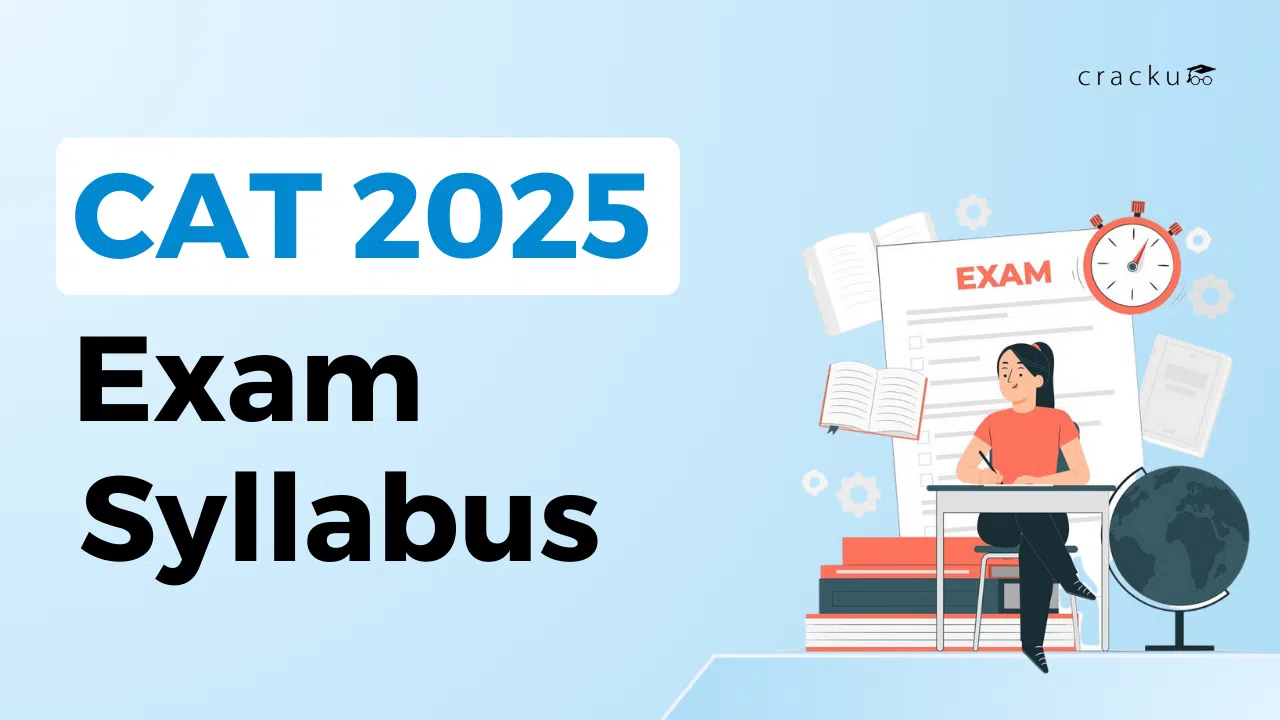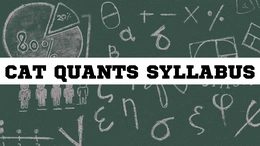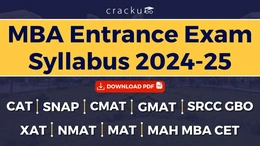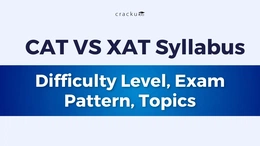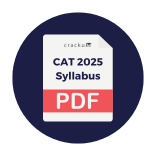CAT exam syllabus: CAT is an aptitude test conducted by top IIMs to evaluate and shortlist candidates for various MBA programs in top b- schools in India. This exam is conducted once annually on the last Sunday of November. This year, it is going to be the 30th of November 2025. This blog provides a detailed section-wise strategy for covering the CAT exam Syllabus 2025. Aspiring candidates should be aware of the topics and the latest changes in the CAT exam pattern. If you want to learn more about the syllabus, you can check out the CAT Exam syllabus PDF by Cracku.
CAT Exam Syllabus 2025: Overview
The CAT exam is divided into 3 sections: VARC, DILR and Quantitative aptitude. Further, the exam has 2 types of questions: MCQs (Multiple Choice Questions) and TITA questions, where you have to type the answer in the space given. Take a look at the sections in the below table:
| CAT 2025 Sections | Section Overview | Number of Questions |
| Verbal Ability and Reading Comprehension (VARC) | The VARC section tests your comprehension skills. | 24 |
| Logical Reasoning and Data Interpretation (LRDI) | The LRDI section tests the candidate's logical reasoning and data interpretation capabilities. | 22 |
| Quantitative Aptitude (QA) | The quantitative aptitude (QA) evaluates the candidate based on mathematical aptitude. | 22 |
CAT Exam Pattern and Syllabus
The CAT exam pattern is of the utmost importance when preparing for the exam. In CAT 2024, there were some changes in the CAT exam pattern compared to CAT 2023. In the DILR section, the total no. of questions was changed from 20 to 22, and the format of the questions was also changed from the earlier 4 sets of 5 questions each to 2 sets of 5 questions and 3 sets of 4 questions each. The expected CAT 2025 exam pattern is given in the table below.
| Particulars | Exam Pattern |
| Mode of CAT 2025 exam | Computer Based |
| No. of Slots | 3 |
| Total number of questions in the exam | 68 |
| Section Wise Time Limit | 40 minutes per section |
| Exam Duration | 120 Minutes (2 Hours) |
| Question Types | Multiple Choice Questions and Type In the Answer (TITA) |
| Marking Scheme for MCQs | 3 marks for each correct answer -1 for an incorrect answer 0 marks for unattempted questions |
| Marking Scheme for Non-MCQs | 3 marks for each correct answer No negative marks for non-MCQ type questions. |
| Sequence for Answering | Students must answer the sections in the specific order mentioned below: 1. VARC 2. LRDI 3. QA The sequence of sections cannot be changed. |
What is the CAT Exam Syllabus for MBA?
The CAT exam syllabus consists of topics from the 3 sections of the CAT exam namely:
- VARC - Verbal Ability and Reading Comprehension
- DILR - Data Interpretation and Logical Reasoning
- QA - Quantitative Aptitude.
It helps you understand the topics on which you can expect questions in the exam, which further helps you prepare for the given exam. The CAT exam syllabus gives you a basic understanding of the topics you need to focus on and the topics you need to skip in order to prepare efficiently for the exam.
CAT Exam Section Wise Syllabus
As discussed earlier, the CAT exam syllabus has three sections: VARC, LRDI, and Quants. In the VARC section, the majority of the questions are from reading comprehension, and the rest are from the verbal ability part. The LRDI section contains topics like arrangements, puzzles, and caselets. Similarly, the Quants section consists of topics like arithmetic, algebra, and geometry. The detailed CAT exam section-wise syllabus is discussed below:
CAT VARC Syllabus 2025
The CAT VARC syllabus primarily focuses on Reading Comprehension, which includes four reading passages. This section comprises 24 questions in the exam. Candidates preparing for CAT 2025 can refer to the CAT VARC syllabus below. The important topics will help identify key areas to focus on during preparation. The VARC section comprises 66.66% reading comprehension and 33.33% verbal ability questions. Some Important Topics for the CAT reading comprehension part are given in the table below:
| Topics | Description |
| Psychology | These are a bit easier to attempt if you are well-versed in these types of articles. |
| Society | These Kind of topics generally deal with societal issues. |
| History | It involves passages about Indian as well as about global history, favourable to someone with a History background. |
| Arts and Museum | Art and paintings have been the favourites of CAT RC passages for a long time. |
| Science and Technology | Scientific RCs are based on Physics, Chemistry, Space, and related topics often come in the exam. |
| Biology | These passages are based on core biology, such as Genes, Darwin's theory, or something related to plants and animals. |
| Philosophy | It is generally based on the eras of Aristotle, Kant, and Marcus Aurelius. The passages are sometimes difficult to read and understand. |
| Culture | Here, you will find articles on different cultures, people, languages, etc. |
The CAT Verbal Ability syllabus is an important part of the CAT exam syllabus. It consists of 8 questions, with 2 questions from Out of the Context, 3 questions each from Para Summary and Para Insertion. The best thing about this part of the VARC section is that it takes less time to attempt. People generally make the mistake of not practicing enough for VA. It is a scoring section if students practice well.
| Topics | Description |
| Para Summary | Here, you will be given a short paragraph, and you have to mark the option that most aptly summarizes that paragraph. |
| Para Jumbles | Here, you will be given 4 Jumbled sentences and you have to arrange them in sequence. |
| Para Completion (Fill in the Blank) | Here, one sentence is missing, and four blanks are given. You have to place the missing sentence in the right place. |
| Odd One Out (Out of the Context) | Here, 5 Jumbled sentences will be given and 1 will be out of the context and you have to choose that sentence. |
Note: The VA part of the VARC section changed slightly in 2024. There were no Para jumbles in CAT 2024; instead, there were 3 questions each from para summary and para completion and 2 questions from out-of-context.
CAT DILR Syllabus 2025
The LRDI section consists of 22 questions in the exam. The CAT DILR syllabus is given separately in the tables below. This section comes after the VARC section. It is notoriously famous for its difficulty level. Review each topic mentioned in the CAT exam syllabus to ace this section.
Logical Reasoning is one of the most important parts of this section. There are 5 sets in each slot in this section, and at least 2-3 sets were from the logical reasoning section. So, take this part seriously; otherwise, avoiding this part will prove to be a blunder in the exam. Let's learn about the detailed CAT exam 2025 syllabus of this section.
| Topic | |
|---|---|
| Selection | Arrangements |
| Case-based LRs | Games & Tournaments |
| Binary Logic | Coin Picking |
| 2D and 3D LR | Truth and Lie |
| Conditional LRs | Puzzles |
Data Interpretation is a very important component of the CAT exam syllabus 2025. It focuses on the ability to analyze and interpret data presented in various formats such as tables, charts, and graphs. Typically, candidates can expect around 1-2 sets of data interpretation questions in each exam slot. A good amount of practice is needed to score well on these types of questions.
| Topics | |
|---|---|
| Venn Diagrams | Graphs |
| Tables-Based DI | Routes and Networks |
| Mathematical Puzzles | Maxima-Minima |
| Charts | Networks and Diagrams |
| Caselets | Quant-Based DI |
Note: The DILR exam pattern may vary, as it was modified in last year's CAT. Therefore, practice solving different types of LRDI sets, including those with 4, 5, and 6 questions.
CAT Quant Syllabus 2025
This section has 22 questions in the exam. The CAT Quant syllabus is an integral part of the CAT exam syllabus which includes basic math concepts to check how well you can apply them in different situations. The main topics covered are Arithmetic, Geometry, Algebra, and Modern Maths. To score well, studying all the topics in the CAT 2025 syllabus is important.
CAT Arithmetic Syllabus
The CAT Arithmetic syllabus includes important math topics that often appear in the Quant section of the exam. Since Arithmetic is a big part of the CAT 2025 syllabus, it's very important to understand it well. Usually, students can expect around 8-9 questions from this topic.
| CAT Arithmetic Topics | |
|---|---|
| Profit & Loss | Time & Work |
| Ratios & Proportions | Averages |
| Time, Speed & Distance | SI and CI |
| Mixtures & Alligations | Percentages |
CAT Algebra Syllabus
It is also one of the most important part of the CAT exam Syllabus. Generally, around 4-5 questions are usually asked in the exam. To improve understanding, it is recommended to study all the key Algebra topics in the CAT 2025 syllabus.
| CAT Algebra Topics | |
|---|---|
| Functions & Graphs | Polynomials |
| Logarithms | Linear & Quadratic Equations |
| Surds & Indices | Inequalities |
CAT Geometry Syllabus
In the exam, students can expect about 4-5 questions from this section. Geometry is slightly more challenging at first while practising, but with regular practice, it can be mastered easily. It has a huge weightage when it comes to overall CAT exam syllabus.
| CAT Geometry Topics | |
|---|---|
| Quadrilaterals | Mensuration (3D) |
| Circles | Polygons |
| Coordinate Geometry | Mensuration (2D) |
| Lines & Angles | Triangles |
CAT Number System Syllabus
The detailed syllabus for the topic Number System is given in the table below. Students generally can expect 1-2 questions from this topic.
| CAT Number System Topics | |
|---|---|
| HCF & LCM | Properties of Numbers |
| Base System Conversions | Divisibility |
| Factors | Remainders |
CAT Modern Maths Syllabus
This topic generally carries less weightage in CAT exam syllabus. Students can expect 1-2 question from this topic.
| CAT Modern Maths Topics | |
|---|---|
| Probability | Set Theory |
| Venn Diagrams | Series and Progressions (AP, GP) |
| Permutations | Combinations |
CAT Miscellaneous Syllabus
The CAT exam syllabus includes some miscellaneous topics that don't usually appear in the exam, but one question sometimes appears in some slots.
| CAT Miscellaneous Topics | |
|---|---|
| Trigonometry | Data Sufficiency |
| Clocks | Calendar |
CAT Exam Syllabus PDF
The CAT exam syllabus PDF not only provides a detailed section-wise syllabus but also offers valuable insights into the exam. It includes information on the sources of VARC passages, topic-wise weightage, score vs. percentile analysis, and more. Additionally, the syllabus PDF can help aspirants make strategies for preparation by understanding the most important topics and their relevance in the exam.
Downloading the CAT 2025 syllabus PDF is quick and hassle-free. We have provided a direct download link—simply click the download button to get instant access to the pdf.
CAT Preparation Strategy 2025
Some tips to prepare for CAT 2025 effectively are mentioned below:
How to Prepare for CAT VARC?
Read regularly: Consistently read 2-3 articles online daily to develop reading habits and improve VARC skills. Cracku provides 3 CAT daily articles, which allow aspirants to read new articles daily.
Practice Reading Comprehension (RCs): Regularly solve RC passages from Cracku's CAT study material to improve your reading and comprehension skills. Remember, practicing more RCs is the key to improving your VARC score.
Go Through Previous Papers: Review past CAT papers to understand the question patterns in the VARC section. It will give you a fair understanding of what to read while practising.
Grammar and Vocabulary: Learn grammar rules and build your vocabulary to perform well in sentence correction and para-summary questions. Though grammar is not directly asked in the exam, but to make sense of the passage, it is necessary.
Take Mock Tests: Attempt mock tests often to boost speed and accuracy. Start with sectional tests before moving to full-length mocks. Timed mocks are essential to improve speed and accuracy in exam conditions.
How to Prepare for CAT DILR?
Solve CAT Previous Papers: Solving past year's CAT paper is the best way to start your DILR preparation; it will give you an idea of what sets you must practice.
Practice Different DI Sets: Solve tables, graphs, charts, and caselets to improve data interpretation skills. You can use Cracku's study material for practice, which contains hundreds of good quality DI sets.
Solve Logical Puzzles: Try puzzles like seating arrangements, Sudoku, Kakuro, etc., to develop logical ability and think strategically, which is very important when solving LRDI sets under exam conditions.
Focus on Accuracy: Aim for accuracy, even if it takes time. Initially, you can spend up to 20-25 minutes per set. You can gradually reduce your time of solving to 15 minutes, which is a good time to solve an LRDI set.
How to Prepare for CAT Quants?
Master the Basics: Fundamentals are very important for CAT quants. Just by clearing your basic quant concepts, you can solve 6-7 questions in the quants section of the CAT exam.
Practice Every Day: Dedicate daily time to solving quantitative problems. CAT Daily Targets is a great tool for staying consistent. You will be provided with 1 RC, 1 DILR set, and 5 quant questions with video solutions daily.
Use Shortcuts: Learn shortcuts like percentage-to-fraction conversions, squares, and cubes to solve questions faster. Speed Maths is a great free tool to boost calculation speed.
Work on Weak Areas: Identify difficult topics and focus on improving them through CAT mock tests. Analysing your sectional and mock tests is very important so that you will get to know your strengths and weaknesses.
CAT Exam Syllabus 2025: Conclusion
The CAT exam syllabus plays a vital role in your preparation; aspirants should be well-versed with every topic mentioned in the syllabus. CAT consists of 3 three main sections—VARC, DILR, and Quantitative Aptitude; candidates must focus on developing their reading skills, logical reasoning, and basic mathematical concepts in order to ace the exam.
Candidates can use tools like speed maths to improve calculation speed. Regular practice, solving previous year papers, and taking mock tests will help improve accuracy and speed. Additionally, working on weak areas and using smart strategies like shortcuts can improve performance. Stay consistent, follow a structured study plan, and keep practicing to maximize your chances of success.
